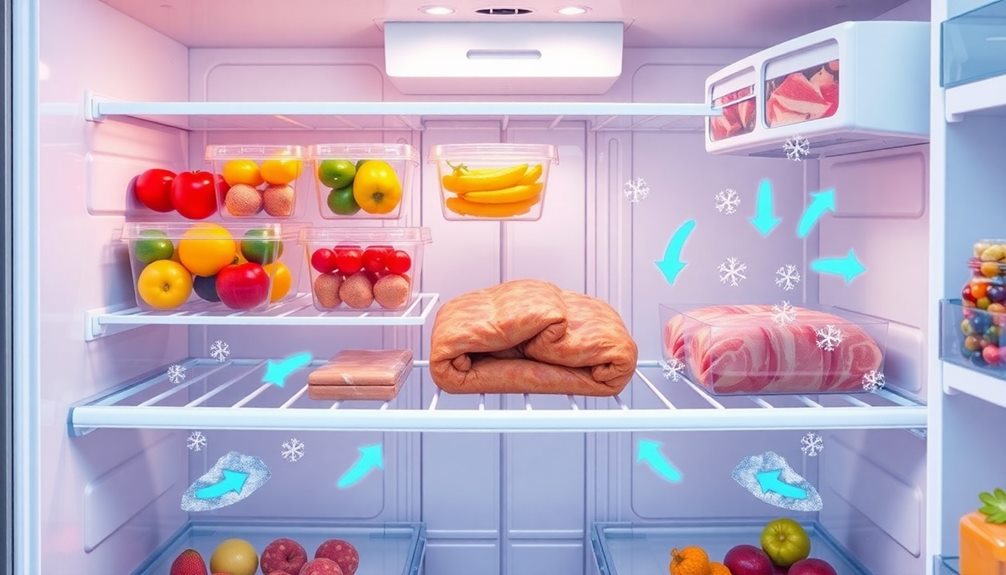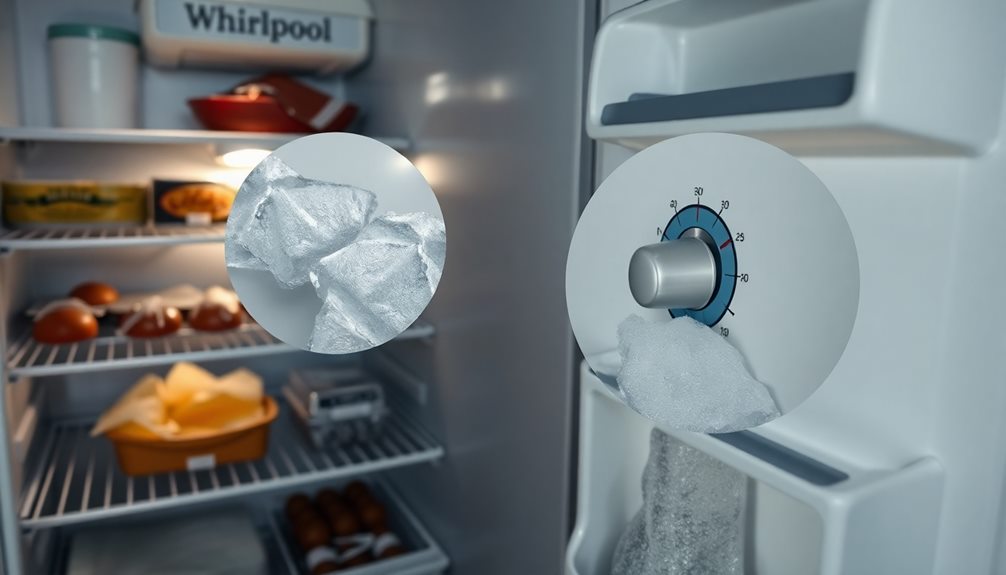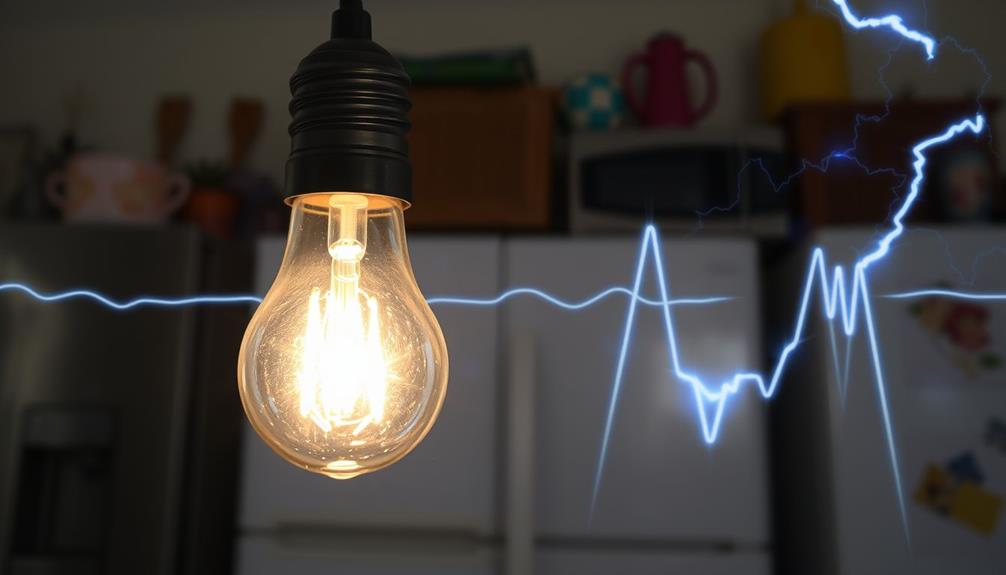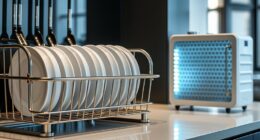If your Whirlpool fridge is freezing your food, you've likely got temperature settings or airflow issues at play. Make certain your fridge is set between 37°F and 40°F. If it's too cold, food can freeze. Keep a one-inch clearance around items for proper airflow and guarantee your fridge is at least three-quarters full to avoid cold spots. Don't forget to clean the condenser coils regularly for better efficiency, and check for any component failures like a malfunctioning thermostat or damper. These steps can help, but there's more to take into account to prevent freezing in the future.
Key Takeaways
- Ensure your fridge temperature is set between 37°F to 40°F to prevent freezing food.
- Maintain at least a one-inch clearance around walls for proper airflow and circulation.
- Keep the refrigerator at least three-quarters full to avoid cold air settling and creating cold spots.
- Regularly clean the condenser coils every 6-12 months to maintain efficiency and prevent freezing issues.
- Check for potential component failures like a malfunctioning damper or thermostat that could disrupt temperature regulation.
Refrigerator Temperature Settings

When it comes to refrigerator temperature settings, finding the right balance is vital for food safety. You should aim for a refrigerator temperature between 37°F and 40°F. For your Whirlpool refrigerator, the perfect temperature is 37°F if you have a digital model. If you're using a dial model, set it to 3 for ideal cooling.
If you notice that your food is freezing, it's a clear sign that your temperature setting might be too low. In that case, consider adjusting the temperature slightly warmer to resolve the issue.
It's also important to regularly monitor the temperature, as factors like external temperatures and power outages can affect your refrigerator's internal climate.
After you make any adjustments, give it about 24 hours for the internal temperature to stabilize before you evaluate the effectiveness of the change. This waiting period guarantees that the new temperature setting has adequately affected the environment inside your fridge.
Airflow and Food Placement

Maintaining the right temperature in your Whirlpool refrigerator isn't the only factor that affects food safety; proper airflow and food placement play significant roles as well.
To guarantee ideal airflow, keep a one-inch clearance around the walls and avoid blocking air vents with stored items. This allows cold air to circulate freely, helping maintain stable temperatures throughout your fridge.
Aim to keep your refrigerator at least three-quarters full. This prevents cold air from settling and reduces the risk of food freezing in lower drawers. When placing items, store them evenly to promote effective air circulation; overstuffing can create cold spots that lead to freezing.
Utilize the crisper drawers wisely by stocking them to no more than half capacity. Adjusting the humidity controls in these drawers can also help prevent moisture buildup, which contributes to food freezing.
Regularly rearranging and decluttering your fridge enhances airflow, reducing the chances of freezing, especially in sensitive areas like the crisper drawers.
Impact of Empty Space

An empty refrigerator can create significant problems for food preservation. When your fridge is too empty, it struggles to maintain consistent temperatures, which can lead to cold spots that freeze your food—especially in the crisper drawers.
Cold air needs something to circulate around, and without enough stock, that air settles in pockets, creating freezing issues. Insufficient items also mean inadequate insulation, increasing the likelihood of temperature fluctuations. You might notice that certain foods, like fruits and vegetables, get icy or even freeze solid.
To combat this, consider using storage containers to organize your items effectively, maximizing space and helping to maintain ideal stock levels. This way, you prevent excessive cold air from directly affecting the placement of your food.
Regularly checking and replenishing your refrigerator guarantees it remains efficiently stocked. Keeping it at least three-quarters full allows it to absorb cold air better, stabilizing the internal temperatures and minimizing freezing risks.
Maintenance of Condenser Coils

To keep your Whirlpool refrigerator running smoothly, regular maintenance of the condenser coils is crucial. Cleaning these coils every 6-12 months helps prevent inefficiency and guarantees peak cooling performance. When the coils are dirty, excess cold air can lead to freezing issues within the refrigerator compartments, making everything from your fruits to leftovers inedible.
Here's a quick guide to help you with the maintenance process:
| Step | Description |
|---|---|
| 1. Disconnect | Always disconnect the power for safety. |
| 2. Access | Locate the condenser coils, usually behind the fridge. |
| 3. Clean | Use a vacuum brush attachment or soft cloth to remove dust and debris. |
| 4. Check | Inspect for damage or wear during cleaning. |
| 5. Reconnect | Plug the refrigerator back in and check performance. |
Proper maintenance of the condenser coils not only enhances energy consumption but also extends the lifespan of your appliance. By keeping those coils clean, you can avoid unnecessary freezing issues and enjoy consistent cooling.
Potential Component Failures

When your Whirlpool refrigerator starts freezing food, it could be due to several component failures. One common culprit is the damper control assembly. If it malfunctions, excessive cold air from the freezer can flow into the refrigerator, leading to frozen food items.
Another potential issue is a defective thermistor. This component monitors air temperature, and if it fails, it can disrupt temperature regulation, causing your fridge to operate too cold.
Additionally, if the thermostat control stops working, it may trigger continuous cooling cycles, further contributing to freezing conditions. The air diffuser motor is also critical; if it malfunctions, the flap may not close properly, allowing excess cold air to enter the refrigerator instead of maintaining balanced air flow.
To prevent these problems, regular refrigerator maintenance is vital. Inspecting these components can help you identify potential failures before they become significant issues.
Frequently Asked Questions
Why Does My Whirlpool Refrigerator Keep Freezing My Food?
If your refrigerator keeps freezing your food, check the temperature settings, guarantee proper airflow by avoiding overcrowding, and inspect for blocked vents or a malfunctioning damper. Regularly clean the condenser coils for peak performance.
Why Has My Fridge Started Freezing Food?
If your fridge is freezing food, check the temperature settings, avoid overcrowding, guarantee air vents are clear, inspect the damper control, and maintain the condenser coils. These steps'll help restore proper food preservation.
What Temperature Should a Whirlpool Refrigerator Be Set At?
You should set your Whirlpool refrigerator between 37°F to 40°F for ideal food preservation. If you're using a dial, setting it to 3 usually works well. Regularly check the temperature with a thermometer for accuracy.
How Do You Reset the Freezer on a Whirlpool Refrigerator?
It's funny how a simple reset can solve so many issues. To reset your Whirlpool freezer, unplug it for 5-10 minutes, then plug it back in. Wait 24 hours to check the temperature.
Conclusion
If your Whirlpool fridge is freezing your food, it's time to take action. Think of your fridge as a delicate ecosystem; every element must work in harmony. By adjusting temperature settings, optimizing airflow, ensuring there's enough space, and keeping those condenser coils clean, you can restore balance. Don't ignore the signs of potential component failures either—catching them early is like nipping a weed in the bud. With a little care, your fridge can thrive without turning your meals into ice blocks!










